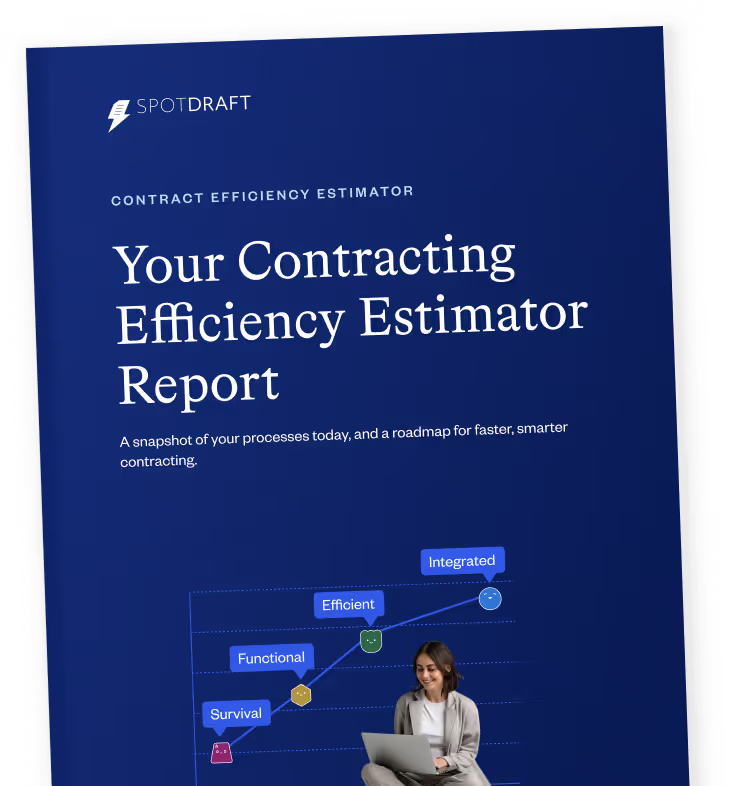Contract disputes are common in business, and when they arise, they can be both time-consuming and expensive to resolve.
In 2019, Apple and Qualcomm were embroiled in a dispute that escalated into an intense legal battle across multiple countries. Apple claimed that Qualcomm was charging too much for their technology patents, while Qualcomm accused Apple of violating their agreements and using their patents beyond the scope of their contract. The case dragged on for two years and only halted after a multi-billion dollar compensation from Apple to Qualcomm.
Apple would’ve prevented this if it had a clear plan in place for dispute resolution in its contract with Qualcomm.
In this guide, we will explore all that you need to know about contract disputes, from prevention methods to negotiation strategies.
What is a contract dispute?
A contract dispute is a conflict between two or more parties over the terms, interpretation, or execution of a legally binding agreement. This can arise due to a breach, miscommunication, or differing interpretations of the contract's terms or clauses.
A contract dispute usually results in legal actions (like Apple and Qualcomm). However, it can sometimes be resolved through alternative means, as Google and Uber did in 2018.
Types of contract disputes
.avif)
Contract disputes come in many shapes and sizes. But they all occur when a breach, misinterpretation, or miscommunication happens during contract execution. Thus, the nature of each dispute and the appropriate resolution approach will largely depend on the surrounding circumstances.
Here are some common examples:
#1. Billing disputes
If a company has a contract with a vendor to supply materials, and the vendor bills the company for an amount that appears to be higher than what was agreed upon in the contract, a billing dispute may arise. The company may dispute the invoice and refuse to pay the full amount until the issue is resolved.
Also, if the company discovers that it has been overpaying the vendor based on an inflated invoice, it may raise a dispute and ask for a refund.
#2. Misrepresentation or fraud
A contracting party can raise a dispute on misrepresentation or fraud when there's evidence that the counterparty knowingly falsifies or negligently omits essential information that influences the party's decision to enter into the contract.
For example, if a car seller misrepresents a vehicle's mileage to make it appear less, the buyer may have grounds to raise a dispute or sue for damages.
Also, a contractor who submits a false invoice or uses substandard materials to complete a project may be guilty of fraud. The buyer may decide to raise a dispute around this and seek justice.
#3. Non-compete violation
A non-compete agreement refers to a contract that prohibits an employee from engaging in a competing business or working for a competitor for a specific period after leaving their current job.
In 2016, Arthur Valdez resigned after 16 years of working for Amazon as its supply chain executive, overseeing international supply-chain expansion operations for the company.
He had left Amazon to assume a new high-ranking position at Target, one of Amazon's biggest competitors. Amazon filed a lawsuit as soon as it heard the news of his recent appointment, citing that it needed to keep Arthur from using the “confidential strategic knowledge” he possessed to benefit a direct competitor.
The case ultimately settled out of court, with Target agreeing to pay Amazon an undisclosed sum and Valdez being barred from working for Target for an agreed duration.
#4. Indemnification disputes
An indemnification dispute typically arises when one party to a contract seeks to recover losses or damages from the other party based on a provision in the contract that requires one party to indemnify the other for certain types of losses or liabilities.
For example, a construction contract may contain an indemnification clause that requires the contractor to indemnify the owner for any damages or losses that happen because of the contractor's work. If a defect in the construction work causes damage to the property, the owner may seek to recover the cost of repairs from the contractor under the indemnification clause.
However, disputes can arise when the parties disagree over whether the indemnification clause applies to a particular situation or over the scope of the indemnification obligation.
For instance, the contractor may argue that the defect was not caused by its work or that the owner seeks to recover more than what is covered by the indemnification clause.
This was the nature of the case between BP Oil and Transocean during the Deepwater Horizon Oil Spill of 2010.
#5. Intellectual property (IP) disputes
Intellectual property disputes arise when there is a dispute over the ownership, use, or protection of IP rights, such as patents, trademarks, copyrights, or trade secrets.
These disputes can involve issues such as infringement, licensing, assignment, and validity of IP rights. Parties to a contract may include terms related to the ownership and use of intellectual property, and such contractual terms can form the basis for a contract dispute. These disputes can be complex and require specialized legal expertise to resolve.
This was the nature of Qualcomm’s case against Apple in 2017. The company alleged that Apple violated several technology patent rights in its iPhones, iPads, and Apple Watches and sought to ban the sale of Apple products in several countries. This dispute dragged on for two years, only losing heat in 2019 after both companies reached an agreement.
Interestingly, Apple tried to raise a new claim against Qualcomm’s patent rights twice in 2022. However, the court declined to hear the company’s bid.
6 Steps to avoid contract disputes

It is true that you cannot predict when or where your contract partner will breach an agreement. However, by implementing the tips below, you can reduce the chances of contract disputes occurring.
#1. Clearly define the terms of the contract to avoid confusion
A clear and concise definition of the terms and expectations of the contract in writing is crucial to avoid future disputes.
The contract should outline the scope of work, timelines, deliverables, and the responsibilities of each party. A clear understanding of the terms helps set expectations and avoid misinterpretations that could lead to conflicts.
#2. Use plain language to avoid ambiguity
Using plain language in a contract can help avoid ambiguity and confusion. Contracts that are overly complex or written in legal jargon can be difficult to understand, leading to disputes.
Using plain language makes the contract terms clear and easy to comprehend for both parties. It also reduces the chances of misunderstandings and misinterpretations that can arise from confusing language.
#3. Get it in writing for a clear record
Verbal agreements can get misinterpreted, and if it leads to disputes, it can be difficult to prove in court. Having everything in writing ensures that there is a clear record of what was agreed upon by both parties. It also provides a reference point for any disagreements that may arise in the future.
#4. Communicate regularly to prevent minor issues
Regular communication between parties is crucial to ensure everyone is on the same page and address any issues as they arise. This can prevent minor problems from becoming more significant disputes.
Communication should be frequent and open, with both parties providing updates on the status of the work and discussing any concerns or changes. This approach can help to establish a positive working relationship between parties, foster trust, and reduce the likelihood of disputes.
Remember that communication should be respectful and professional, focusing on finding resolutions rather than assigning blame.
#5. Include dispute resolution mechanisms for quicker results
Including dispute resolution mechanisms in the contract can provide a process for resolving disputes without resorting to litigation, which can be costly and time-consuming.
Dispute resolution mechanisms can include mediation or arbitration, which are less formal and less expensive than going to court. These mechanisms can also be more efficient and provide quicker results.
Ensure that the dispute resolution mechanisms are agreed upon by both parties in advance and that they are clear and enforceable.
#6. Maintain a record of everything for clarity
Keeping detailed records of all communications and transactions related to the contract can provide evidence in case of any disputes.
This includes emails, invoices, receipts, and other relevant documents. Having a clear record of all the communication and transactions helps provide clarity and resolve any disputes that may arise.
It is important to keep these records in a secure location where they can be easily accessed if needed.
Also read: What is Contract Compliance? The Ultimate Guide
How to deal with contract disputes?
.avif)
The choice of the contract resolution technique depends on the form and complexity of the dispute, the parties' preferences, and the contract's terms. Here are some common contract dispute resolution techniques:
#1 Negotiation
"Negotiation is 90% preparation, 10% talking."
~ Sterling Miller, CEO of Hilgers Graben PLLC
Ten Things: Business Skills All In-House Lawyers Should Master
Negotiation is a common and flexible contract resolution technique where parties discuss the issue and try to find a mutually acceptable solution.
While negotiation is ideally a collaborative process, you have to be in control of the situation by being emotionally intelligent and strategic in your assertions to get the best results.
- Avoid emotional responses
When negotiating a contract dispute, the counterparty might try to cut you off mid-speech or impose their opinions. Do not react in the same way. Instead, take a short pause, and remind them of the goal of the conversation.
- Highlight how your proposal will benefit them
Talking solely about your interests during negotiations will not always work in your favor. A better approach is to structure your proposal in a way that highlights what the counterparty stands to gain (or lose) by addressing the situation (or refusing to do so).
- Allow time to work in your favor
Some proposals won't immediately sit well with the counterparty. When negotiating, ensure the counterparty is aware of what's at stake, and if they're being defensive, tell them not to feel under pressure. Give them a specific duration to go over your proposal and come back with a response.
Also read: 5 Most Negotiated Contract Terms and Clauses
#2 Mediation
Mediation is a resolution technique that involves a neutral third party, called the "mediator," who helps the parties to reach an agreement. The mediator facilitates communication between the parties but does not decide on outcomes or impose solutions.
The mediator's objective is to help the parties to understand each other's positions and interests, explore possible solutions, and find a mutually acceptable agreement.
The process typically begins with an opening statement by the mediator, followed by statements from each party outlining their position. The mediator then collaborates with the parties to identify areas of agreement and explore possible solutions. The parties may meet together or separately with the mediator, depending on the situation.
Unlike litigation or arbitration, where a third party makes a binding decision, mediation allows the parties to come to a mutually acceptable solution that meets their needs. Mediation is also confidential, which means that discussions and documents produced during the process are generally not admissible in court.
“Unfortunately, many in-house lawyers — or their clients – treat mediation like a poor cousin to arbitration and waste the opportunity. This is usually because of either indifference or the idea that you can “just show up” and mediate. Wrong!“
~ Sterling Miller, CEO of Hilgers Graben PLLC
Ten Things: Getting the Most out of Mediation
#3 Arbitration
Arbitration is a contract dispute resolution method where a neutral third party, called the "arbitrator," makes a binding decision on the dispute. The disputing parties agree to submit their dispute to arbitration, and they are bound by the arbitrator's decision.
Arbitration can be either mandatory or voluntary, depending on the terms of the contract.
Mandatory arbitration clauses are common in many contracts, particularly in industries where disputes are common—e.g., construction. In these cases, the parties agree in advance to submit any disputes to arbitration rather than going to court.
Arbitration processes are less formal than court proceedings but more formal than mediation processes. The arbitrator is typically an expert in the subject of the dispute, and the process may involve discovery, witness testimony, and other procedures similar to a court proceeding.
#4 Litigation
In litigation, the disputing parties present their arguments and evidence to a judge or jury, who then makes a final decision on the dispute. When one party alleges that the other party has breached the terms of the contract. The party presents its arguments and evidence to the court, and the judge or jury makes a decision on the case.
Litigation is a formal and structured process that involves filing legal documents, conducting discovery (such as depositions and requests for documents), and presenting evidence at trial.
One of the advantages of litigation is that it provides a formal and enforceable decision from a court of law. However, the process can be slow and expensive, and the outcome is not guaranteed.
How can SpotDraft reduce the risk of contract disputes?
A Contract Lifecycle Management (CLM) system like SpotDraft can reduce the risk of contract disputes in several ways:
Standardization: By allowing you to use standardized templates, SpotDraft can help ensure that contracts are consistent and comprehensive, reducing the risk of ambiguity or misunderstandings.

Automation: SpotDraft can automate many aspects of contract management, including contract creation, approval workflows, and renewal reminders. This can help ensure that contracts are properly reviewed, approved, and executed, reducing the risk of errors or omissions.

Centralization: SpotDraft provides a centralized repository for all contract-related information, including contract documents, revisions, and correspondence. This makes tracking and managing contract changes, preserving evidence, and streamlining processes easier.

Collaboration: SpotDraft can facilitate collaboration between internal stakeholders, such as legal, finance, and procurement teams, as well as external stakeholders, such as vendors or customers. This helps ensure that everyone is on the same page and that contracts are aligned with business needs and objectives.

Compliance: SpotDraft helps ensure compliance with legal and regulatory requirements, decreasing the risk of non-compliance penalties and disputes.
Also read: How to use a Contract Negotiation Software
Stay proactive with SpotDraft
As an all-in-one CLM, SpotDraft offers all the tools you need to stay productive with contract management, maintain compliance, and reduce the chances of disputes.
This includes an AI-powered system that analyzes contract terms and flags potential risks or inconsistencies; a contract editor that facilitates collaborative drafting, redlining, and negotiation; and a centralized repository that stores every contract-related document in a secure and searchable way.
There’s just so much that SpotDraft can do for you as a legal counsel. Request a personalized demo to see how the CLM can help you stay safe from costly disputes and improve your overall contract management productivity.


.avif)







